Achieving Resilience Benefits Through Utility Solar + Storage Deployment & Community Solar Access in Low-Income Communities
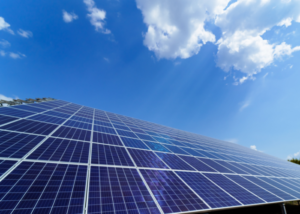 Staff at the NC Clean Energy Technology Center (NCCETC) are currently working on two projects focused on community solar access and achieving resilience benefits for low and moderate-income communities through American Rescue Plan Act (ARPA) funds distributed by the North Carolina Department of Health and Human Services (NCDHHS). The two ARPA funded projects the NCCETC is supporting are: Community Solar Access for Low and Moderate-Income Utility Customers; and Achieving Resilience Benefits Through Utility Solar + Storage Deployment in Low-Income Communities.
Staff at the NC Clean Energy Technology Center (NCCETC) are currently working on two projects focused on community solar access and achieving resilience benefits for low and moderate-income communities through American Rescue Plan Act (ARPA) funds distributed by the North Carolina Department of Health and Human Services (NCDHHS). The two ARPA funded projects the NCCETC is supporting are: Community Solar Access for Low and Moderate-Income Utility Customers; and Achieving Resilience Benefits Through Utility Solar + Storage Deployment in Low-Income Communities.
The American Rescue Plan Act, or ARPA, was passed in March 2021 to provide direct relief to Americans, contain the COVID-19 virus, and rescue the economy. According to the NCDHHS website, ARPA funds will be used to strengthen current health and human services-related programs and invest in new programs.
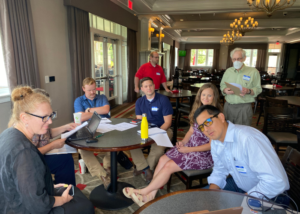 Earlier this month, at the July 12 Community Solar Workshop: Increasing Benefits from a Community Solar Project in North Carolina, hosted by the NC Clean Energy Technology Center, stakeholders heard from David Sarkisian of the NC Clean Tech Center, Jill Cliburn of the consulting firm, Cliburn and Associates, and Bob Leker, of the NC Department of Environmental Quality. There were representatives from several cooperative utilities, municipal utilities, community groups, and Department of Environmental Quality staff in attendance.
Earlier this month, at the July 12 Community Solar Workshop: Increasing Benefits from a Community Solar Project in North Carolina, hosted by the NC Clean Energy Technology Center, stakeholders heard from David Sarkisian of the NC Clean Tech Center, Jill Cliburn of the consulting firm, Cliburn and Associates, and Bob Leker, of the NC Department of Environmental Quality. There were representatives from several cooperative utilities, municipal utilities, community groups, and Department of Environmental Quality staff in attendance.
At the workshop, attendees spent time in small groups to discuss the feasibility of community solar best practices including subscription models, commitment terms, income verification, bill credits, REC allocations, and strategies such as energy storage integration, repowering, scaling, lower income specific rates, and opt-out programs. After the small groups discussed how to increase benefits with community solar, the Department of Environmental Quality led a discussion about program development in order to address the challenges and increase the number of low to moderate income customers served by community solar, and to include community solar in a resiliency strategy in the face of increased severe weather events.
Community Solar Access for Low and Moderate-Income Utility Customers
The Community Solar Access for Low and Moderate-Income Utility Customers project builds on the NCCETC’s previous work to distribute funds for community solar subscriptions at cooperative and municipal utilities in North Carolina. In the project’s second round, the funding will aim to broaden the spectrum of beneficiaries and foster development of self-sustaining subscription support programs by encouraging applicant utilities to use the funds received to complement replicable lower-income support programs developed by the utilities themselves and funded using non-government sources.
Along with the higher cost of installations and space requirements associated with rooftop solar photovoltaic systems, lower-income community members face many barriers to accessing renewable energy like solar power. Community solar programs make solar more accessible to all Americans, especially those with low-to-moderate incomes, because it allows energy users to subscribe to a shared system of solar panels, often located within their community.
“Community solar enables all electric customers – whether owning or renting – to participate in renewable energy from the local power grid without the effort and expense of installing solar panels themselves,” said David Sarkisian, Senior Project Manager for NCCETC’s Policy Team and principal investigator for the ARPA projects.
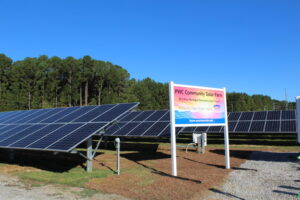 Past work, such as Fayetteville Public Works Commission’s fully-subscribed community solar farm, has shown community solar to be a viable program model for participation in North Carolina’s solar economy. However, current community solar programs in the state are relatively small, and the marginal economic benefits of these programs mean that they are often of little appeal to lower-income potential participants.
Past work, such as Fayetteville Public Works Commission’s fully-subscribed community solar farm, has shown community solar to be a viable program model for participation in North Carolina’s solar economy. However, current community solar programs in the state are relatively small, and the marginal economic benefits of these programs mean that they are often of little appeal to lower-income potential participants.
To help address these barriers, this project will take an alternative approach to improve the benefits of community solar for participants by improving the underlying economics of the technology involved in the community solar program. NCCETC’s past experience with community solar in the southeastern U.S. indicates that inclusion of battery storage within a community solar program could result in improved economics for the program, allowing the utility involved to offer a more attractive subscription for participants.
Battery energy storage is an important new technology in the energy market, and can complement renewable power generation to offer an improved value proposition for the combined technologies. NCCETC will assist utilities interested in establishing or expanding community solar programs by performing feasibility analyses for these programs and modeling incorporation of battery storage in order to improve the value proposition of community solar for both utilities and subscribers.
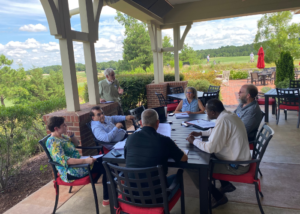 Cliburn & Associates, LLC are partnering with NCCETC once again to combine the energy storage valuation model developed by the Solar-Plus for Electric Cooperatives project with a community solar evaluation model, allowing a wider range of benefits from energy storage to be taken into account in community solar projects. This new modeling tool will be made publicly available to make it easier for utilities to explore the costs and benefits associated with deployment of a solar + storage project.
Cliburn & Associates, LLC are partnering with NCCETC once again to combine the energy storage valuation model developed by the Solar-Plus for Electric Cooperatives project with a community solar evaluation model, allowing a wider range of benefits from energy storage to be taken into account in community solar projects. This new modeling tool will be made publicly available to make it easier for utilities to explore the costs and benefits associated with deployment of a solar + storage project.
While community solar programs with better underlying economics have a greater chance to be an attractive proposition for lower-income customers, this alone may not be enough to bring community solar to everyone who may benefit. One solution may be employing an opt-out community program to overcome the information barriers to lower-income participants. Opt-out programs automatically enroll customers while providing the option to cancel subscription if desired.
“As part of this project, NCCETC is developing a prospective program design for an opt-community solar program for at least one of the participating utilities,” stated Sarkisian, “The program’s design will include guidance requiring that customers that are automatically enrolled will receive net bill savings in all subscription periods.”
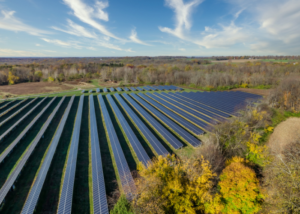 NCCETC will research current and emerging best practices on community solar program design for low-income participants, updating information gathered originally through the Community Solar for the Southeast project. To supplement these best practices with lessons learned through existing programs in this state, NCCETC will engage with stakeholders in North Carolina as well as the perspectives of local residents, businesses, utilities, governments, and nonprofit organizations on possible program improvements.
NCCETC will research current and emerging best practices on community solar program design for low-income participants, updating information gathered originally through the Community Solar for the Southeast project. To supplement these best practices with lessons learned through existing programs in this state, NCCETC will engage with stakeholders in North Carolina as well as the perspectives of local residents, businesses, utilities, governments, and nonprofit organizations on possible program improvements.
Repowering Existing Community Solar Systems
Carolina Solar Services, LLC has joined NCCETC to support analysis of the potential for repowering existing photovoltaic arrays with new modules for increased generation and new inverters for increased up-time, among other repowering strategies. The goal of this area of the project will be to evaluate the potential to expand the capacity of existing community solar arrays interconnected to the distribution infrastructure of rural electric cooperatives in North Carolina.
“The purpose of this cost-benefit analysis is to not only consider whether the investment to repower these assets can yield benefits greater than those costs, but also to see whether any net benefit can specifically be allocated to reduce the energy cost burden of low-income rural consumers,” Sarkisian explained. Based on recommendations from a preliminary report from Carolina Solar Services, NCCETC will study the incorporation of battery storage, to understand the potential to replicate and scale a pilot initiative statewide.
Achieving Resilience Benefits Through Utility Solar + Storage Deployment in Low-Income Communities
Recently, investor-owned utilities in some regions of the United States have begun offering “Community Resiliency” programs wherein a commercial-scale customer (often a school, church or community center) hosts utility-owned solar-plus-storage system, which can provide economic and resilience benefits for the customer, the utility and the surrounding community.
 “Community resiliency programs can help supply power during extended outages and natural disasters- which tend to hit underserved communities harder,” noted Elizabeth Bowen, Senior Project Manager for NCCETC’s Clean Power & Industrial Efficiency Program. In a coastal state like North Carolina, worsening weather events like hurricanes are causing longer and more frequent power outages. High wind and flooding are critical threats to the state’s grid, and under-served, rural communities in eastern North Carolina are disproportionately affected by longer recovery times during outages.
“Community resiliency programs can help supply power during extended outages and natural disasters- which tend to hit underserved communities harder,” noted Elizabeth Bowen, Senior Project Manager for NCCETC’s Clean Power & Industrial Efficiency Program. In a coastal state like North Carolina, worsening weather events like hurricanes are causing longer and more frequent power outages. High wind and flooding are critical threats to the state’s grid, and under-served, rural communities in eastern North Carolina are disproportionately affected by longer recovery times during outages.
NCCETC’s second ARPA project will seek to create a scalable, cost-effective community resiliency program model for electric cooperatives to help address hurricane-related resilience needs. In consultation with Roanoke Electric Cooperative (REC), NCCETC will design and conduct feasibility tests for community resiliency service programs involving utility or third party-owned energy storage system deployment to support critical community centers. REC will identify customers with resiliency needs in underserved communities, and will facilitate the deployment of solar-plus-storage assets.
As part of the projects’ ongoing effort to engage stakeholders, another workshop will be held in September 2022. Contact Elizabeth Bowen with the NC Clean Energy Technology Center at etbowen@ncsu.edu to learn more.